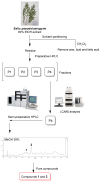Bioactive Phytochemicals from Salix pseudolasiogyne Twigs: Anti-Adipogenic Effect of 2'- O-Acetylsalicortin in 3T3-L1 Cells
- PMID: 36233307
- PMCID: PMC9570486
- DOI: 10.3390/ijms231912006
Bioactive Phytochemicals from Salix pseudolasiogyne Twigs: Anti-Adipogenic Effect of 2'- O-Acetylsalicortin in 3T3-L1 Cells
Abstract
Salix pseudolasiogyne (Salicaceae) is a willow tree and has been used as a medicinal herb in Korea to treat pain and fever. As a part of an ongoing study to identify bioactive natural products, potential anti-adipogenic compounds were investigated using the ethanol (EtOH) extract of S. pseudolasiogyne twigs. Phytochemical investigation of the EtOH extracts using liquid chromatography-mass spectrometry (LC/MS) led to the separation of two compounds, oregonin (1) and 2'-O-acetylsalicortin (2). The structures of the isolates were identified using nuclear magnetic resonance spectroscopy and LC/MS analysis. To the best of our knowledge, it is the first report identifying oregonin (1) in twigs of S. pseudolasiogyne. Here, we found that the isolated compounds, oregonin (1) and 2'-O-acetylsalicortin (2), showed anti-adipogenic effects during 3T3-L1 cell differentiation. Notably, 2'-O-acetylsalicortin (2), at a concentration of 50 µM, significantly suppressed lipid accumulation. Moreover, the mRNA and protein levels of lipogenic and adipogenic transcription factors were reduced in 2'-O-acetylsalicortin (2)-treated 3T3-L1 cells. Taken together, these results indicate that 2'-O-acetylsalicortin (2), isolated from S. pseudolasiogyne twigs, has the potential to be applied as a therapeutic agent to effectively control adipocyte differentiation, a critical stage in the progression of obesity.
Keywords: 2′-O-acetylsalicortin; Salix pseudolasiogyne; adipocyte differentiation; adipogenesis; obesity.
Conflict of interest statement
The authors declare no conflict of interest.
Figures





References
-
- Freischmidt A., Jürgenliemk G., Kraus B., Okpanyi S., Müller J., Kelber O., Weiser D., Heilmann J. Contribution of flavonoids and catechol to the reduction of ICAM-1 expression in endothelial cells by a standardised Willow bark extract. Phytomed. Int. J. Phytother. Phytopharm. 2012;19:245–252. doi: 10.1016/j.phymed.2011.08.065. - DOI - PubMed
MeSH terms
Substances
Grants and funding
LinkOut - more resources
Full Text Sources
Research Materials

